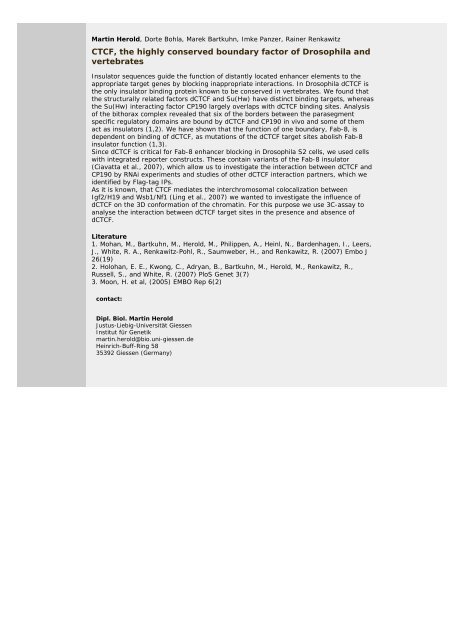Abstracts (poster) - Wissenschaft Online
Abstracts (poster) - Wissenschaft Online
Abstracts (poster) - Wissenschaft Online
Create successful ePaper yourself
Turn your PDF publications into a flip-book with our unique Google optimized e-Paper software.
Martin Herold, Dorte Bohla, Marek Bartkuhn, Imke Panzer, Rainer Renkawitz<br />
CTCF, the highly conserved boundary factor of Drosophila and<br />
vertebrates<br />
Insulator sequences guide the function of distantly located enhancer elements to the<br />
appropriate target genes by blocking inappropriate interactions. In Drosophila dCTCF is<br />
the only insulator binding protein known to be conserved in vertebrates. We found that<br />
the structurally related factors dCTCF and Su(Hw) have distinct binding targets, whereas<br />
the Su(Hw) interacting factor CP190 largely overlaps with dCTCF binding sites. Analysis<br />
of the bithorax complex revealed that six of the borders between the parasegment<br />
specific regulatory domains are bound by dCTCF and CP190 in vivo and some of them<br />
act as insulators (1,2). We have shown that the function of one boundary, Fab-8, is<br />
dependent on binding of dCTCF, as mutations of the dCTCF target sites abolish Fab-8<br />
insulator function (1,3).<br />
Since dCTCF is critical for Fab-8 enhancer blocking in Drosophila S2 cells, we used cells<br />
with integrated reporter constructs. These contain variants of the Fab-8 insulator<br />
(Ciavatta et al., 2007), which allow us to investigate the interaction between dCTCF and<br />
CP190 by RNAi experiments and studies of other dCTCF interaction partners, which we<br />
identified by Flag-tag IPs.<br />
As it is known, that CTCF mediates the interchromosomal colocalization between<br />
Igf2/H19 and Wsb1/Nf1 (Ling et al., 2007) we wanted to investigate the influence of<br />
dCTCF on the 3D conformation of the chromatin. For this purpose we use 3C-assay to<br />
analyse the interaction between dCTCF target sites in the presence and absence of<br />
dCTCF.<br />
Literature<br />
1. Mohan, M., Bartkuhn, M., Herold, M., Philippen, A., Heinl, N., Bardenhagen, I., Leers,<br />
J., White, R. A., Renkawitz-Pohl, R., Saumweber, H., and Renkawitz, R. (2007) Embo J<br />
26(19)<br />
2. Holohan, E. E., Kwong, C., Adryan, B., Bartkuhn, M., Herold, M., Renkawitz, R.,<br />
Russell, S., and White, R. (2007) PloS Genet 3(7)<br />
3. Moon, H. et al, (2005) EMBO Rep 6(2)<br />
contact:<br />
Dipl. Biol. Martin Herold<br />
Justus-Liebig-Universität Giessen<br />
Institut für Genetik<br />
martin.herold@bio.uni-giessen.de<br />
Heinrich-Buff-Ring 58<br />
35392 Giessen (Germany)

















